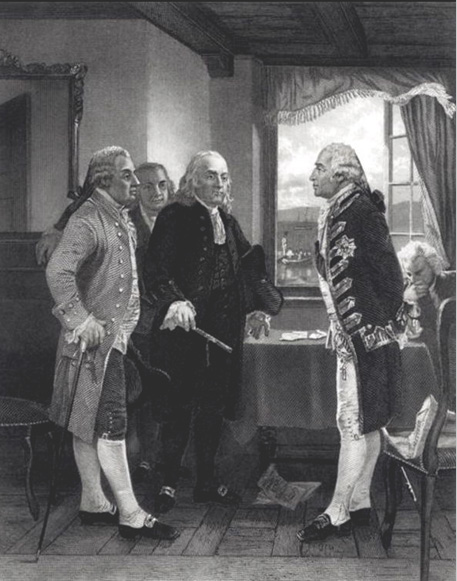
Peace Conference on September 11, 1776 on Staten Island, New York at the Billopp House (The Conference House) Between Admiral Howe and Representatives of the Second Continental Congress. L-R: John Adams, Edward Rutledge, Benjamin Franklin, Admiral Lord Richard Howe, Howe’s secretary Henry Strachey (seated). Image Courtesy of the Artist’s Web Site – AlonzoChappel.org.
225 years before the year which will always now be associated with the date September 11 at a location 19.2 miles to the south west of Ground Zero, an attempt at a peace conference to put an end to the American Revolutionary War occurred on Staten Island. On September 11, 1776, following the recent successful battle for Long Island by the British against the Continental Army of the recently self declared United States of America, Admiral Lord Richard Howe met with three representatives of the Second Continental Congress. Admiral Howe was in command of all British navel forces in North American waters and brother of Major General William Howe, the British Commander-in-Chief of North America, and victor of the Battle of Long Island. Admiral Howe was attempting to end the 17 month long conflict which ignited on April 18, 1775 when the first shots of the Revolution were fired at Lexington, Massachusetts, as the British were on their way to seize the colonial militia’s munitions stored in Concord.
The names of two of the three representatives, Benjamin Franklin and John Adams, should be household names to modern day Americans. We’ll let people slide if they are not as familiar with the name of the third Continental Congress representative, Edward Rutledge of South Carolina. Admiral Howe was reaching out to his acquaintance Benjamin Franklin, whom he had known in London before the war, when Mr. Franklin used to play chess with the Admiral and General’s widowed sister, Caroline. In actuality, during this time period Admiral Howe and Mr. Franklin were trying to resolve the problems between Great Britain and its unhappy colonies.
Admiral Howe initiated the peace conference in the aftermath of the invasion of Long Island. During this battle, the Hessians – mercenaries for the British – captured General John Sullivan of the American forces. Sullivan, a lawyer by trade from New Hampshire, was one of two of Washington’s commanders during the battle; the other being General Israel Putnam. General Sullivan was released on parole in order to make contact with the Continental Congress to discuss the possibility of having a meeting to discuss a way to end the conflict. After he was released, General Sullivan met with General Washington then, with Washington’s permission, proceeded to Philadelphia to meet with the Continental Congress.
Another previous attempt by the Howe brothers to end the conflict prior to the invasion of Long Island by directly contacting George Washington was unsuccessful. A big issue in this failure stemmed from the Howes not recognizing George Washington’s title as “General”. This is a common theme when an established government is being rebelled against. The established government does not want the rebelling entity to have any credence or legitimacy to it so the established government will simply just not recognize the rebelling entity. It was along this line of thinking which propelled General Howe to send the letter to “George Washington, Esq.” Washington refused the letter. Howe sent a second letter addressed to “George Washington, Esq., etc., etc.” which was also refused. This time however the messenger was Colonel James Paterson, General Howe’s adjutant-general. When this second letter was refused, Colonel Paterson requested a personal meeting with General Washington. Though they met, again the meeting did not result in an end to the conflict and shortly thereafter, the invasion on Long Island began.
After General Sullivan arrived in Philadelphia and briefed the Continental Congress, the Congress decided to send the three representatives to meet with Admiral Howe. It was Franklin who recommended meeting either at Proprietary House in Perth Amboy, where Franklin’s illegitimate and estranged son, Royal Governor William Franklin had recently been arrested, or at the Billopp House on Staten Island just across the river from Perth Amboy.
A nice succinct summary of the Peace Conference can be found on pages 19-22 of the e-book “The Conference House Revisited. A History of the Billopp Manor House” by Field Horne located on the Conference House web site. (Note that the ebook viewer takes a little getting used to. Use the “1:1” button at the top to enlarge the book to the correct viewing size.)
To make a long story short, Adams, Franklin and Rutledge arrived in Perth Amboy, took the barge supplied by Admiral Howe across the Kill Van Kull to the Billopp House, and met with the Admiral. Though they met for three hours, they came to no agreement. Four days after the conference, the British crossed the East River from Brooklyn and invaded Manhattan Island.
Since the time of the original writing of this, I had never been to the Conference House and didn’t even know about it until the last couple of years before. Since then, I have had the opportunity to visit it as described in this link. Interestingly enough, it is physically located closer to my childhood home in Morgan, NJ than Sayreville War Memorial High School, a place where I further learned about the Revolutionary War and a place where the year after I graduated, a somewhat well known rock star by the name (at the time) of John Francis Bongiovi, Jr. started attending.
Originally posted on September 6, 2010.